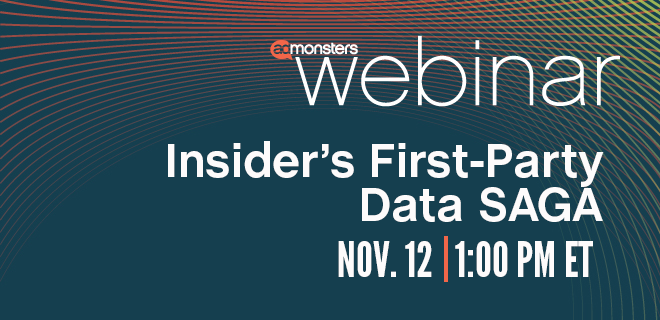
Long before Chrome announced it was killing off support for third-party tracking cookies, Insider Inc. was way ahead of the curve, launching a bold new first-party data platform with great fanfare.
But for many publishers, building out a first-party data strategy doesn’t come without challenges.
In preparation for our upcoming webinar—Insider’s First-Party Data SAGA on November 12 @ 1 PM ET—we caught up with Brett Goverman, Senior Customer Success Manager at Permutive, Insider’s DMP partner in improving advertiser campaign performance using first-party data.
We spoke with Goverman about the challenges publisher’s face in launching a first-party data strategy, as well as the steps any publisher can take with their first-party data to ensure they’ll be able to meet an advertiser’s goals.
Lynne d Johnson: So the beginning of publishers’ first-party data journey often starts because they are unable to get a holistic view of their audience. What are some of the challenges publishers have connecting data across sites to get that holistic view?
Brett Goverman: The two biggest challenges that publishers face when building a comprehensive understanding of their audiences are scale and actionable insights.
Most publishers are resigned to activating audiences in cookie enabled environments. This reliance on third-party cookies eliminates almost 40% of their addressable traffic from Safari and Firefox. Unlocking these audiences is a key first step for any publisher looking to increase scale.
But scale is just one piece of the puzzle. Publishers often struggle to connect audience signals to the commercial goals of their partners. Advertisers are asking publishers to step up to the plate with detailed audience requests and traditional contextual targeting isn’t cutting it. The inability to extract what, why, and when an audience exudes a behavior is a major limiting factor when it comes to creating a company-wide first-party data strategy and winning RFPs.
LdJ: What do publishers gain by connecting all of this data across their organization? Can you share any examples of what success looks like?
BG: The current digital advertising ecosystem is stacked against publishers. Google and Facebook have seen the lion’s share of digital ad revenue. With the announcement of the end of the third party cookie, now is the time to shift the balance of power back to publishers. A strong first-party data strategy empowers publishers to go on the offensive and recoup lost revenue.
Publishers are able to provide premium content in a brand-safe environment. To capitalize on this strength publishers must uncover audience insights that deliver improved performance at every stage in a customer’s journey. That’s exactly what Insider has done; it created a holistic view of its users with first first-party data and is using this to win RFPs and drive revenue. You can learn more about how Insider is using data in the webinar next week.
Data benefits teams across the entire organization including sales, account management, and analytics. A strong understanding of their audience enables publishers to quickly provide a data-driven response the moment an RFP is received. More importantly, the data collected can enable publishers to position themselves as strategic partners by providing robust post-campaign analytics. This helps their advertisers improve future campaign performance.
In addition to ad sales, first-party data can be used to inform decisions and optimize processes across any publisher organization. Whether you’re trying to understand what kind of audiences drive the most revenue from the open market, tailoring your editorial, or testing the impact promotions have on your subscription funnel, having first-party data at your fingertips is a vital tool in driving success.
LdJ: You’ve already stated that one of the biggest challenges many publishers have building a first-party data strategy is scale. How can publishers approach this challenge? Not every publisher has millions of unique views like Insider, any advice for those publishers?
BG: It’s up to the publisher to understand their audiences and provide recommendations for their partners to help them achieve their goals. Obviously not every publisher can provide millions of uniques for every campaign. To tackle this problem head on it’s important to understand what tools are available that can facilitate audience extension.
The good news is that if you’ve done the legwork of standing up a first-party data strategy, this is relatively easy. With first-party insights, you know what kinds of actions, content, and interests your audiences are more likely to have.
Publishers should also be thinking about new strategies to collect more first-party data, via tools like surveys, webinars, or newsletters. This can help learn more about their audiences.
If an advertiser is looking to extend their reach for a specific audience, publishers can leverage their in-depth knowledge of their audiences to make recommendations. For example, “Our foodie segment is 5x more likely to be interested in automobile content.” Publishers can recommend including this audience in the next campaign for a partner looking to target auto enthusiasts.
LdJ: We often hear that advertisers aren’t flocking to contextual targeting because well, the third-party cookie still exists. And of course, contextual is still somewhat hard to measure. Is contextual really the heir apparent of third-party cookies and how can pubs get advertisers on board?
BG: Contextual targeting is an important part of every publisher’s audience targeting strategy, but it is just one strategy.
Permutive enables publishers to collect contextual and behavioral signals to segment their audiences far beyond simple contextual targeting. Enriching contextual segmentation with behavioral signals and declared data, where available, can help publishers meet any advertiser’s KPIs.
Whether the aim of a campaign is to build brand awareness or to target a set of users in the market to make a purchase, Permutive can help publishers go beyond just contextual targeting by layering a multitude of behavioral signals to derive true interest and intent.
And be sure to join AdMonsters Webinar on Nov. 12 at 1 pm ET to learn more about Insider Inc’s first-party data SAGA.
